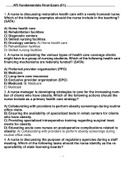-
1. Examen - Ati fundamentals proctored exam | questions and answers with rationales | latest
-
2. Examen - Ati fundamentals proctored exam study guide 2022/2023
-
3. Examen - Ati fundamentals proctored exam latest / ati fundamentals proctored exam study set
-
4. Examen - Ati fundamentals practice a, b, & final, ati fundamentals review 2019 /ati fundamenta...
-
5. Examen - Ati fundamentals proctored exam study guide 2022/2023
-
6. Examen - Ati fundamentals final exam (f1)
-
7. Examen - Ati fundamentals practice a, b, & final, ati fundamentals review 2019
-
8. Examen - Ati fundamentals practice a, b, & final, ati fundamentals review 2019
-
9. Examen - Ati fundamentals final exam (f1) 2023
-
10. Examen - Ati fundamentals proctored exam 2023
-
11. Examen - Ati fundamentals exam 2023
-
12. Examen - Ati fundamentals 2 quiz 2023
-
13. Examen - Rn vati fundamentals 2019 assessment (answered) retake 2022
-
14. Examen - Ati fundamentals proctored exam updated and graded a+
-
15. Examen - Ati fundamentals exam
-
16. Examen - Ati fundamentals questions and answers with rationales
-
17. Examen - Ati fundamentals questions and answers with rationale
-
18. Examen - Ati fundamentals practice a 2023/2024
-
19. Examen - Ati fundamentals a, b and final ati fundamental review 2019
-
20. Examen - Ati fundamentals exams| questions and answers with rationale
-
21. Examen - Ati fundamentals answered a nurse is preparing to administer an injection of an opi...
-
22. Examen - Ati fundamentals 2019 proctored exam | fundamentals proctored exam
-
23. Examen - Ati fundamentals 1 quiz
-
24. Examen - Ati fundamentals proctored exam updated and graded a+ | latest 2023/2024 177 question...
-
25. Examen - Ati fundamentals 2019 proctored review 166 questions with answers
-
26. Examen - Ati fundamentals proctor 2023
-
27. Examen - Ati fundamentals proctored exam study guide. ahip 2022/2023
-
28. Examen - Ati fundamentals
-
29. Examen - Ati fundamentals practice test b
-
30. Examen - Ati fundamentals proctored exam
-
31. Examen - Rn vati fundamentals 2019 assessment
-
32. Examen - Rn vati fundamentals assessment
-
33. Examen - Ati fundamentals practice test b
-
34. Examen - Ati fundamentals practice a 2019
-
35. Examen - Ati fundamentals practice a 2019
-
36. Examen - Ati fundamentals retake proctored
-
37. Examen - Ati fundamentals practice test b proctored 2023
-
38. Examen - Ati fundamentals exam 1 practice questions 2023/2024
-
39. Examen - Ati fundamentals exam 1 practice questions 2023/2024
-
40. Examen - Ati fundamentals nclex questions 2023/2024 proctored
-
41. Examen - Ati fundamentals proctored exam study guide
-
42. Examen - Ati 2019 fundamentals proctored exam, ati fundamentals retake
-
43. Examen - Ati fundamentals (dynamic quizzes)
-
44. Examen - Ati fundamentals proctored exam
-
45. Examen - Ati fundamentals module 1 chapters 1-4, 16-17, 23-25
-
46. Examen - Ati fundamentals final exam (f1)
-
47. Examen - Ati fundamentals practice test b
-
48. Examen - Ati fundamentals proctored exam study guide. 2022/2023
-
49. Examen - Ati fundamentals review module
-
50. Examen - Ati fundamentals practice test a with ngn
-
51. Examen - Ati fundamentals cms proctored exam 2023/ 2024 latest!!! 210 questions and verified a...
-
52. Examen - Pn ati fundamentals 2023/2024
-
53. Examen - Ati fundamentals practice a, b, & final, ati fundamentals review 2019
-
54. Examen - Ati fundamentals retake
-
55. Examen - Ati fundamentals remediation 2023/2024
-
56. Examen - Ati fundamentals 2
-
57. Examen - Ati fundamentals 2 quiz 2023
-
58. Examen - Ati fundamentals b 25 questions only with answers 2023/2024
-
59. Examen - Ati fundamentals proctored 2023/2024
-
60. Examen - Ati fundamentals proctor 2023
-
61. Examen - Ati fundamentals
-
62. Examen - Ati fundamentals proctor 2019
-
63. Examen - Ati fundamentals proctored exam study guide 2024
-
64. Examen - Ati fundamentals proctored exam a&b
-
65. Examen - Ati 2023 fundamentals proctored exam, ati fundamentals retake
-
66. Examen - Ati fundamentals proctored exam study guide
-
67. Examen - Ati fundamentals proctor 2023
-
68. Examen - Ati rn fundamentals online practice 2023 b
-
69. Examen - Ati fundamentals proctor 2023
-
70. Examen - Ati fundamentals proctor 2023
-
71. Examen - Ati fundamentals proctor 2023
-
72. Examen - Ati fundamentals proctored exam
-
73. Examen - Ati fundamentals practice exam a
-
74. Examen - Ati fundamentals online practice 2020 b
-
75. Examen - Ati fundamentals online practice 2019 b
-
76. Examen - Ati fundamentals 1 quiz 2024
-
77. Examen - Ati fundamentals final exam (f1)
-
78. Examen - Ati fundamentals proctored exam
-
79. Examen - Ati fundamentals proctor, ati proctor fundamentals 1, ati rn fundamentals proctored e...
-
80. Examen - Ati fundamentals proctored exam
-
81. Examen - Ati fundamentals proctored exam 2024 | questions and answers | latest edition | alrea...
-
82. Examen - Ati fundamentals 2024
-
83. Examen - Ati fundamentals proctored 2023 newest actual exam all 70 questions and correct answe...
-
84. Examen - Ati fundamentals proctored exam 2024
-
85. Examen - Ati fundamentals 2023 proctor
-
86. Examen - Ati fundamentals 2024
-
87. Examen - Ati fundamentals proctored exam, ati fundamentals retake over 200 questions with answ...
-
88. Examen - Ati rn fundamentals online practice 2023 b
-
Mostrar más




